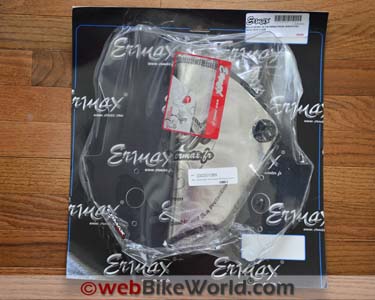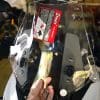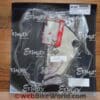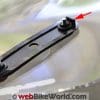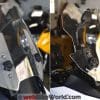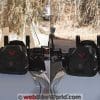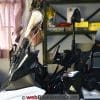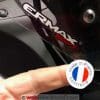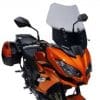Ermax windshields (aka windscreens) are made in France.
Although the Ermax name may be unfamiliar in the U.S.A., Ermax windshields are distributed all over the world.
They make a huge number of windshields in all shapes, sizes and many colors, for many different motorcycles.
Ermax has been involved in MotoGP, Moto 2 and 3 and endurance racing for many years.
They also make all sorts of different products for motorcycles, such as rear huggers, scooter windscreens and more.
The high-tech manufacturing facility in the south of France also designs and makes parts for aerospace and industrial use.
The Ermax Sport Windshield
This is a review of the Ermax “Nose Screen Sport Windshield” for the 2015 Kawasaki Versys 650 LT Project Bike (Blog).
Ermax makes literally thousands of different windshields for many different motorcycles, in a choice of shapes, styles, heights and tint colors, so ours is just a tiny, tiny example of the many different types of windscreens they make.
(By the way, I’m using the word “windscreen” and “windshield” interchangeably in this review.)
For the Versys Project Bike, we ordered the Sport Windshield, which has approximately the same surface area as the stock windshield, but obviously with a much different shape.
Ermax also makes a touring windshield and a “High Protection” windshield with an extra 10 cm height for the 2015+ Versys 650.
They also have a replacement stock windshield for the Versys, but I’m not sure what that one looks like.
The Ermax windscreens are made from thermoformed Plexiglas, nominally 3.0 mm thick.
I measured ours at 3.25 mm thick, using a Starrett 216MXFL-25 (metric) digital micrometer. The stock Kawasaki windscreen measures 3.20 mm thick.
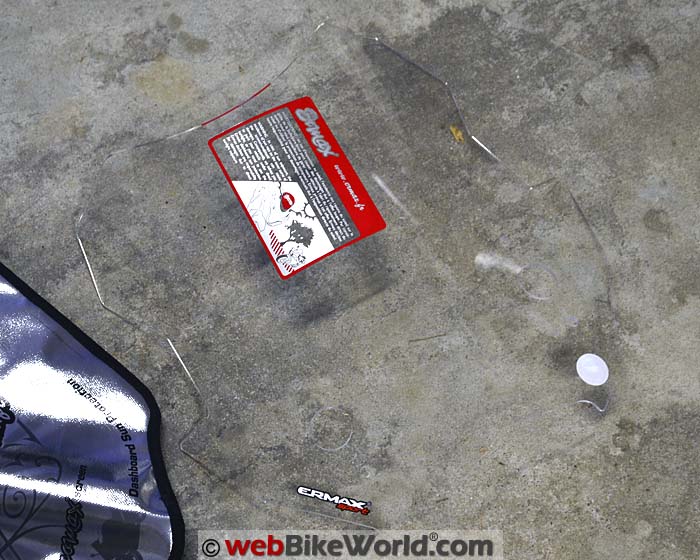
Stock Kawasaki Windshield Notes
Besides the shape, the Ermax windshield it quite a different take on wind protection than the stock Versys windshield.
Not that there’s all that much wrong with the stock windshield; it works pretty well for a factory standard ‘screen but the “pointy” triangular shape could use a touch of improvement, both in terms of aesthetics and performance.
First, the triangular shape seems slightly out of place on the newest version of the Versys, despite the bike’s angular looks.
The stock windscreen lets some air flow around the sides towards the top and combined with the relatively flat front surface of the Kawasaki windshield, the air flow creates some turbulence that can be felt at the upper shoulders and top of the helmet.
Also, the pointed upper part of the stock windscreen focuses the air stream towards the top of the helmet.
This means that with some helmets that have large upper intake vents — like the Arai Corsair-X (review) — the stock windscreen is the cause of some extra noise.
Clarity Differences
Also, the clear plastic of the stock windshield isn’t what I’d call “crystal” clear. It’s close and you might not notice the difference, but when you compare it to the Ermax windshield, the difference is noticeable and the Ermax windscreen is nearly invisible.
In fact, it was hard to take photos of the Ermax windshield because the darn thing is so clear, it’s hard to capture with the camera.
The clarity is noticeably different also when you’re riding the Versys and looking through the windshield.
So overall, the quality of the Plexiglas on the Ermax windshield is excellent and noticeably different from the stock windscreen.
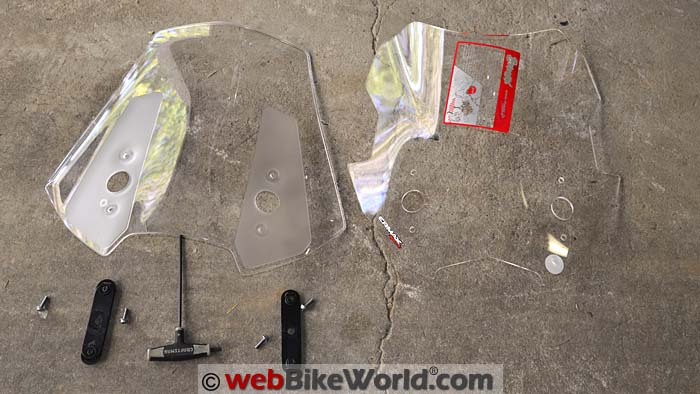
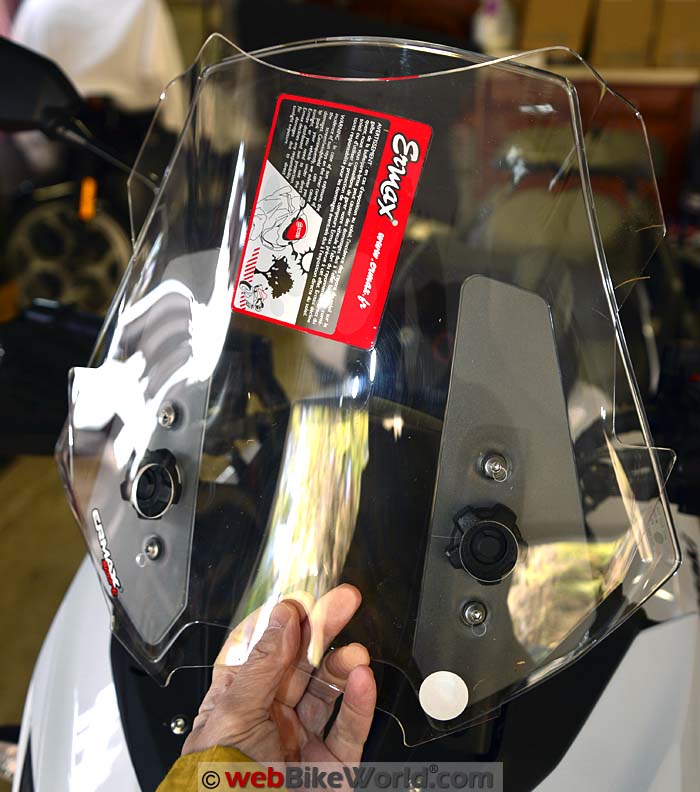
Ermax Sport Windshield Shape
There’s almost no technical information about the Sport Windshield on the Ermax website or the website of Moto Machines, the U.S. importer and distributor, so there isn’t much I can tell you unfortunately.
However, the shape is definitely different from the stock Kawasaki Versys windshield, as you can plainly see.
Why and how Ermax came up with this shape is unknown and we had no specific expectations about it, so the results were rather surprising.
We did not opt for the larger and taller touring screen for no other reason than style considerations.
But for sure, the Ermax windshield looks much cooler compared to Kawasaki’s version and both of us agree on that.
The Ermax ‘screen has a much more complicated shape, but it starts out with just a slight curvature at the bottom and it becomes more curved towards the top.
It then also has a couple of creases on either side of this central curve and it includes square-ish cutouts on either side.
So how would this translate out on the road?

On the Road With the Ermax Sport Windshield
Now I can’t say that the Ermax windshield creates a perfectly calm “bubble” for the rider to enjoy. But that should be obvious based on both the “Sport” size and shape of the replacement windscreen.
However, we both noticed a difference right away in back-to-back initial rides.
The Ermax Sport Windshield seems to push the air just slightly more out to the sides at shoulder height (for a roughly 178 cm rider, or 5’10”).
And that convex cutout along the top of the Ermax windscreen doesn’t mean more air directed at the helmet either, which is another surprise.
The angle of the windscreen and the two creases on either side of center, plus the overall shape, seem to create less turbulence at the top of the helmet and upper body.
This helps flow the air more smoothly around the rider.
It’s not a huge difference, but enough to be noticeable. Maybe around a 25% reduction in turbulence?
So the bottom line here is that we have experienced a slight decrease in noise and turbulence with the Ermax Sport Windshield and both of us noticed this immediately on the first ride, as soon as the bike got up to about 20 MPH or so.
However, if you’re really looking for more wind protection, you might want to go for one of the much larger Ermax windscreens, either the “High Protection” or the Touring windshield. Remember, the one we’re reviewing here is a “Sport” windscreen.
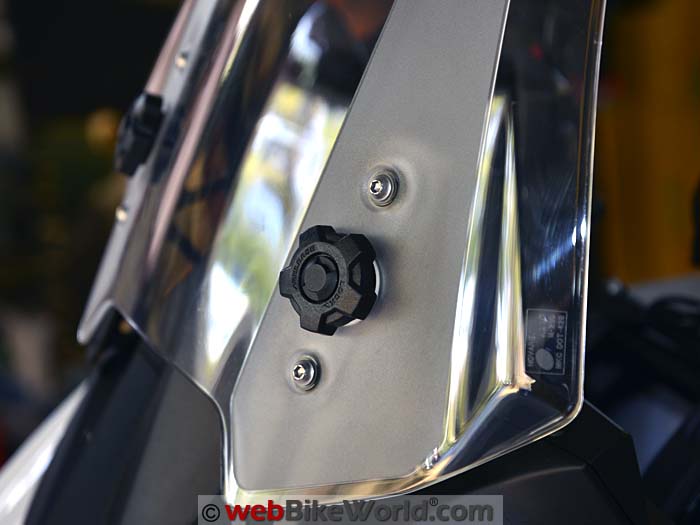
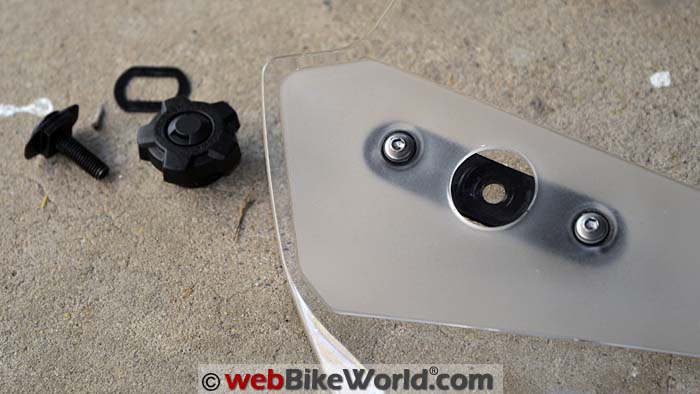
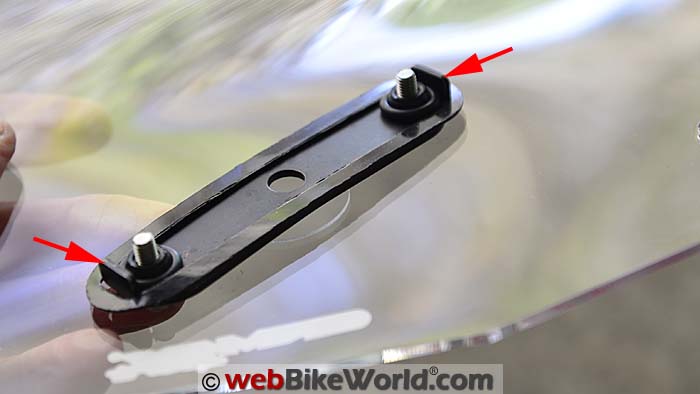
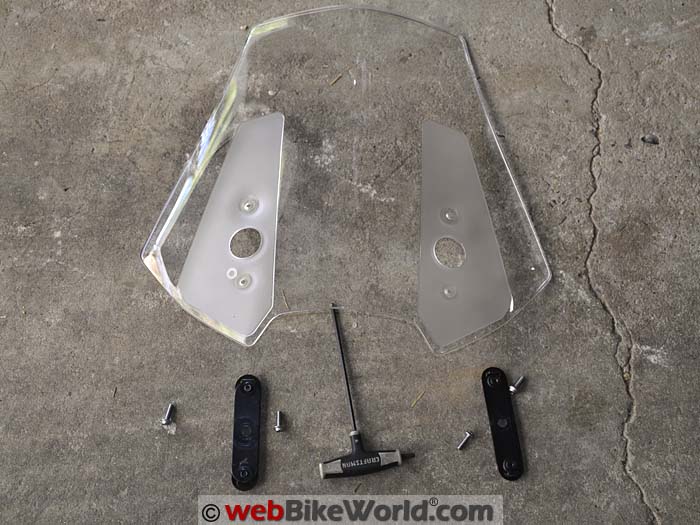
Installation
Of course, installation will be different on every motorcycle, especially if you’re adding a windshield to a bike that didn’t come with one from the factory.
The Ermax replacement windscreens for bikes that had a windscreen from the factory are designed to fit the factory mounting system and ours fit the Versys perfectly.
But let’s take a look at the installation on the Versys 650. It’s pretty easy to install and we’ve tried to illustrate this in our photos also.
The stock windshield has two big round dials in front to manually raise or lower the windscreen. They’re made from plastic with an embedded metal threaded screw that fastens to a special square nut in the rear.
That nut slides on a piece of plastic, which reduces friction as the windshield is raised or lowered.
Also, there are two special 4 mm Allen screws on each side, upper and lower. These hold a metal bracket that slides up and down inside a track in the windshield mounting brackets, one on either side of the Versys’ cockpit.
Plastic sliders are also used here to reduce friction as the windscreen moves up and down in the mounting brackets.
To swap out windscreens, first remove the adjustment dials and then remove the four Allen screws that hold the slider.
But be sure to study the way this is all put together first, before you remove anything; take a few photos with your phone if necessary.
Then it’s simply a matter of replacing the parts on the Ermax windscreen and putting it all back together.
Do not over-tighten the four Allen screws; they only need to be just snug enough to hold the metal slider brackets in place.
The trickiest part is lining up the plastic sliders and getting the flats of the nuts centered in the mounting brackets.
Once that’s done, carefully snug the bolts and you’re done.
It took me much longer to write all of this than it does to install the Ermax windshield; it’s actually a very easy job that anyone can do.
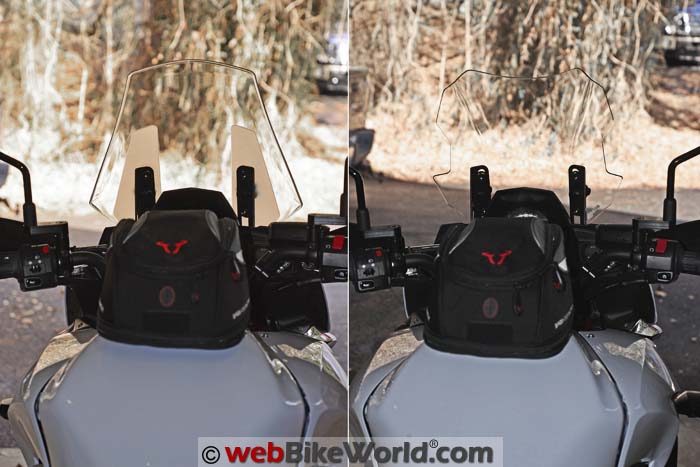


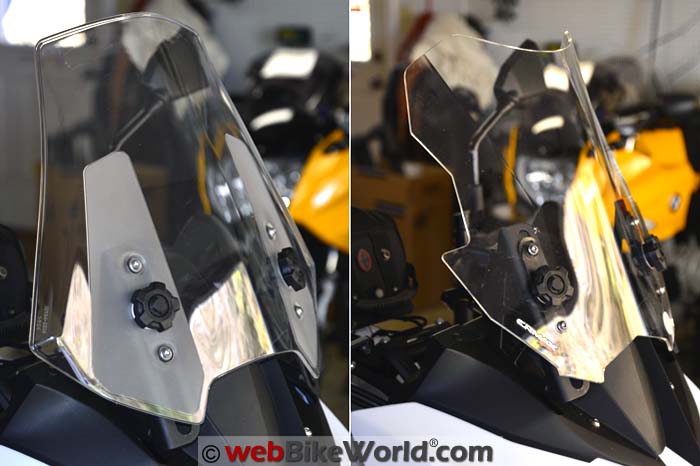


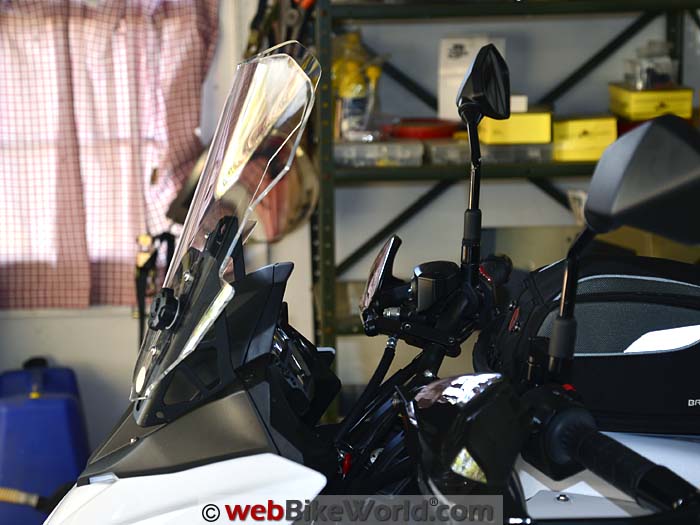


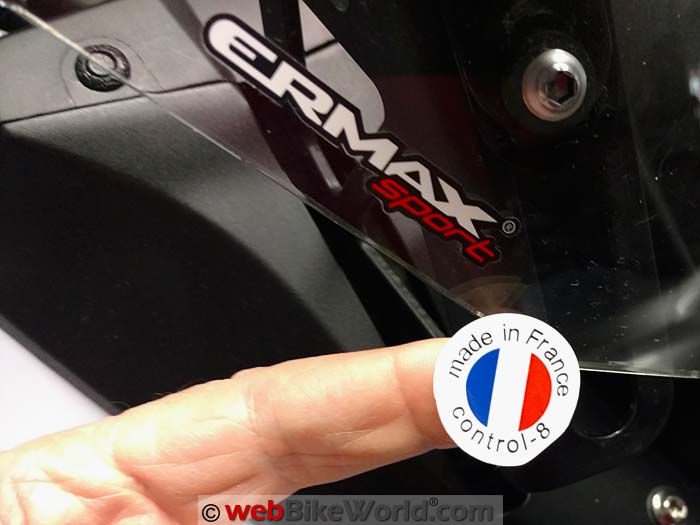


Sun Shade?
The Ermax windshield came with a nice metallic foil sunscreen that has two suction cups on either side.
It’s designed to place this over the front of the windshield when the bike is parked, to prevent the sun from focusing through the curves on the windshield, which can cause damage to the motorcycle’s instruments or dashboard.
This is a real problem; in fact, it has been reported by several scooter owners on the Google+ BMW Scooter Community.
The curves on a windscreen can act like a magnifying glass and the heat can actually melt the plastic on the instruments.
Unfortunately, the sun shield in our Sport Windshield kit is too big to fit. The suction cups are located too far apart to fit the smaller windscreen.
We’re not sure if this was a factory mistake by including the wrong sun shield or if this is the only size sun shield they have.
And one other thing: there’s a “Made in France” sticker, but it was placed on the inside of the windshield, in a location that can’t be seen either by the rider or an onlooker.
It would actually be pretty nice to have a French flag decal on the front of the windscreen, so I suggest that Ermax either re-print the sticker so that it faces forward or better yet, just make a nice little French flag sticker for the lower right-hand corner of the ‘screen.
Conclusion
Ermax makes so many different types of windshields for so many different motorcycles, it’s difficult to come to an overall conclusion based on this one small sample.
But there are a few things I can say: first, the Ermax Sport Windshield definitely looks cooler than the stock Kawasaki windshield, so that counts for something!
The Ermax windshield is also available in different tints, depending on your taste.
The quality of the molding and the clarity of the Plexiglas is noticeably better than the stock windshield, although you might not notice this until you compare the two side-by-side.
And most important, the Ermax Sport Windshield provides smoother air flow or a reduction in turbulence — not by a huge amount, because this is a fairly small windshield — but enough to be noticeable compared to the stock windshield.
We weren’t familiar at all with the Ermax brand before this but next time, Ermax will be on the short list for a windscreen replacement.
Owner Comments and Feedback
See details on submitting comments.
From “M.L.” (March 2017): “I have a 2015 Yamaha FJ09. I found that the Ermax tall clear windshield slightly melted the top of my instrument cluster.
When the sun is behind the bike at about 8 o’clock position, the sun is magnified by the windshield.
I have since replaced the windshield with another aftermarket brand. I think Ermax should correct this defect and they should pay for replacement of my instrument cluster.
When I got their windshield I received no cover to address this and no warning of this happening.”
Editor’s Reply: Actually, this is a problem with many windscreens, even OE windscreens, so it’s something to keep in mind as a possibility with any windshield in certain lighting conditions.
For example, BMW scooter owners have reported a problem with the stock windshield, where under certain lighting conditions and angles with the sun, the focused beam melts the top of the instruments.
I’ve heard of this happening on many other windscreens also. I rarely park a bike outside, so I haven’t experienced it.
From “D.M.” (January 2017): “My experience with windshields has been that you can get better looks or better function (turbulence abatement), but one sacrifices the other.
If Ermax is an exception to this, and at such a reasonable price, they deserve serious consideration.
For those who think the sun shade mentioned is an odd idea, be advised that sun-melting of instrument panels is real.
Both my BMW R1200GS Adventures, 2008 and 2011 models, had the problem of melting the bezel surrounding the speedometer and tachometer, in both cases with the stock factory windshield.
To their credit, BMW replaced the bezel on both under warranty, although not all dealers are even aware that the problem exists.
The fact that I live at 7000′ elevation in a southern U.S. latitude may be a factor here. I tried to develop the habit of covering the instrument panel with a rag whenever I stopped, but would often forget.”


